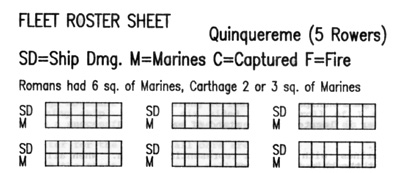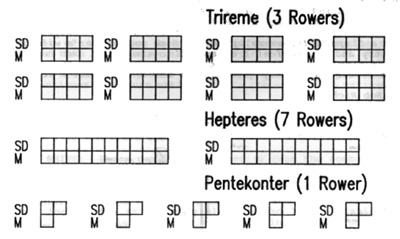MOVEMENT: Type crew (Determine ship or ship's crew qual.):
-
Experienced = 8" movement
Regular = 6" movement
Green = 4" movement
Backing = 1"
An Anastrophe (360 degrees) takes one complete turn. Applies to all crew experience. Movement is considered only under oar power as sails were generally stored or removed to a nearby shore.
RAKE OARS: To rake an opponent one must declare that intention and have enough movement to move along at least one half the length of the opposing ship. Roll 1 six sided die, a roll of 1 or 2 indicates a successful rake and the target ship's speed is cut by one half. If raked again on the other side that ship will be dead in the water for the game as all oars are broken.
DRIFT: At the start of each game roll for drift and direction of the current. Ships still afloat longer than one turn will drift 1 inch per turn in the direction indicated by the drift marker.
RAMMING: Use the ram indicator placing the narrow edge of the template toward the target ship. Ship must be more than 45 degrees past the bow of the target ship in order to ram and have enough movement to do so. Once contact is made the attacker rolls 1 six sided die, the number of pips indicates amount of damage done on the ship. If the damage exceeds number of boxes left for that ship it is sunk. Sinking ships may swamp or pull the ramming ship under on a die roll of 1. The ramming ship must back water to pull away the very next turn if it wishes to move again.
GRAPPLE AND BOARD: Ships passing each other (within 1") may attempt a grapple on a die roll of 1 or 2. Grapples may be cut loose the next turn if a die roll of 1 or 2 is made. A round of combat follows each successful grapple by the marines of each ship. Each side rolling one six sided die, the high roller is the winner, the number of casualties being the difference between the die rolls. If both sides loose all marines in a turn, a roll occurs with the high roller winning the melee and keeping one box of marines to board the captured ship. as long as a grapple exists combat continues each turn until one side looses all its marines.
CROWS: Will work the same as a grapple with the exception that a grapple is made with a die roll of 1 thru 4! It cannot be cut away and can only be raised by its own crew. Marines using a corvus to board add 1 to their die when marines roll.
CAPTURED SHIPS: These usually would retire from the combat when possible as they were manned only with a prize crew and took no further part in the battle.
SHIP'S ARTILLERY: Was made up of catapults and ballista but was somewhat ineffective as a moving platform had little stability. Range is 3" and a die roll of 1 or 2 will inflict one point of damage to target's marines. Various incendiaries were used to set fire to opposing ships.
If the player declares he is using fire then on a roll of 1 the target ship will take a point of fire damage. It will continue to take one point each turn of fire damage, until it is put out or the ship is sunk by fire. A second roll by owning player of ship of 1 will put out the fire. This may be attempted each turn.
WINNING AND GAME POINTS: Each player of a naval squadron scores 1 point for each enemy ship he has sunk, and 2 points for each one captured minus his points lost from his own ships sunk or captured by the enemy. It is recommended that 6 - 12 ships be in a squadron although once comfortable with the rules a player can handle upwards to 24 ships each.
ID number is located on the stand of each vessel.
SD is the ship damage or amount of hits it can sustain before sinking.
M is marines, with each box representing 20 men. When all boxes are lost the ship is captured.
C indicates captured
F indicates damage done by fire to a ship
A indicates points of marines killed by artillery fire or damage to ship (firer chooses and announces before shooting)
Also attached is a sample roster sheet showing the ships/squares for ship damage and marine casualties. Each square should be marked with the appropriate code above as indicated.
Hal, I thought your readers might enjoy the above rules. I've tried them at a convention twice and have played with them at home many times. I use the smaller metal model ships about 1/2 inch in length and have close to 120 vessels per side. It's great to be able to fight the naval battles of the Punic Wars and Greek City State Wars.
A few tips that might help, a small piece of cardboard does well to indicate a Corvus. Also marking the STAT sheet with a capture indicator (C) on the opposing player STAT sheet helps. Also, mounting the ships to cardboard with IDs 1-120 helps and an I for a flagship for every squadron. Hope your readers will give it a try and please feel free to add to the rules, but remember keep it simple, a great deal of complexity and rules does not make a better gamer only gamesmanship and a Gentleman's attitude does.


Back to MWAN #53 Table of Contents
© Copyright 1991 Hal Thinglum
This article appears in MagWeb (Magazine Web) on the Internet World Wide Web.
Other military history articles and gaming articles are available at http://www.magweb.com